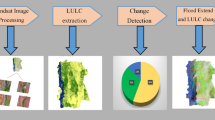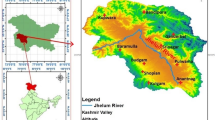Abstract
India has been historically susceptible to natural disasters due to its unique geo-climatic conditions in which the Himalayan ecosystem is very fragile and a little disturbance can cause harmful effects. The present work is an attempt to assess the environmental and livelihood impact of the 2013 flood in Mandakini valley, Uttarakhand (India), using geospatial techniques and an environmental evaluation system. The land use land cover (LULC) maps for the years 2011, 2014, and 2017 (Alaknanda basin) and 1997, 2011, and 2017 (Mandakini basin) were prepared using Landsat satellite imageries, and the statistical changes were estimated in the respective LULC classes derived. The results showed significant changes in terms of LULC dynamics in the whole region. Further, to analyze changes in vegetation cover in the region, Normalized Difference Vegetation Index was calculated, depicting the overall decrease in vegetation cover. By using Battelle Columbus method of environmental evaluation system, the impact of the flood on ecological and cultural aesthetics and human interests, with and without the disaster is also derived. A questionnaire-based survey was conducted in Gaurikund and Kedarnath to assess the repercussions of the flood on the livelihoods of inhabitants. It showed that the stoppage of tourism-based livelihood activities, which were critical to the local people, deems it necessary to map the footprint of the flood on livelihood generation activities. The overall result of this study is that there are significant impacts of flood on both the environment and people residing in the region, and anthropogenic activities were major contributors to the catastrophe. The major outcomes of this analysis will help in creating the baseline data for major disastrous studies in India and also support sustainable management strategies in response to these extreme events.
Access this chapter
Tax calculation will be finalised at checkout
Purchases are for personal use only
Similar content being viewed by others
References
Aerts, R., & Honnay, O. (2011). Forest restoration biodiversity and ecosystem function. BMC Ecology, 11, 29.
Allen, S., Rastner, P., Arora, M., Huggel, C., & Stoffel, M. (2016). Lake outburst and debris flow disaster at Kedarnath, June 2013: Hydro-meteorological triggering and topographic predisposition. Landslides, 13(6), 1479–1491.
Areendran, G., Sahana, M., Raj, K., Kumar, R., Sivadas, A., Kumar, A., et al. (2020). A systematic review on high conservation value assessment (HCVs): Challenges and framework for future research on conservation strategy. Science of the Total Environment, 709, 135425.
Ashraf, S., Iftikhar, M., Shahbaz, B., Khan, G. A., & Luqman, M. (2013). Impacts of flood on livelihoods and food security of rural communities: a case study of southern Punjab, Pakistan. Pakistan Journal ofAgricultural Sciences, 50(4) 751–758.
Bjarstig, T., & Stens, A. (2018). Social value of forests and production of new goods and services: The views of Swedish family forest owners. Small-Scale Forestry, 17(1), 125–146.
Das, R., Borbora, T. K., Sarma, M. K., & Sarma, N. K. (2005). Genotypic variability for grain yield and flood tolerance in semi deep-water rice (Oryza sativa L.) of Assam. Oryza, 42(4), 313.
Das, S., Kar, N. S., & Bandyopadhaya, S. (2015). Glacial lake outburst flood Kedarnath, Indian Himalaya a study using digital elevation model and satellite images. Natural Hazard, 77(2), 769–786.
De Bruin, W. B., Wong-Parodi, G., & Morgan, M. G. (2014). Public perceptions of local flood risk and the role of climate change. Environment Systems and Decisions, 34(4), 591–599.
Dee, N., Baker, J., Drobny, N., Duke, K., Whitman, I., & Fahringes, D. (1973). An environmental system for water resource planning. Water Resource Research, 9(3), 523–535.
Dobhal, D. P., Mehta, M., & Srivastava, D. (2013). Influence of debris cover on terminus retreat andmass changes of Chorabari glacier, Garhwal region, central Himalaya, India. Journal of Glaciology, 59(217), 961–971.
Ferrari, J. R., Lokkingbill, T. R., McCormick, B., Toumund, P. A., & Eshleman, K. N. (2009). Surfacemining and reclamation effects on flood response of watersheds in the central Appalce chain plateau region. Water Resource Research, 45(4).
Guo, B., & Zhang, G. (2009). Land-use change in farming pastoral region of inner magnolia based on GIS and Markov model. Transaction of Chinese Society of Agriculture Engineering, 25/121, 291–298.
Hughes, M. L., McDowell, P. F., & Marcus, W. A. (2006). Accuracy assessment of georectified aerial photographs: Implications for measuring lateral channel movement in a GIS. Geomorphology, 74(1–4), 1–16.
Khatun, S., Sahana, M., Jain, S. K., & Jain, N. (2018). Simulation of surface runoff using semi distributed hydrological model for a part of Satluj Basin: Parameterization and global sensitivity analysis using SWAT CUP. Modeling Earth Systems and Environment, 4(3), 1111–1124.
Martha, T. R., Roy, P., Govindharaj, K. B., Kumar, K. V., Diwakar, P. G., & Dadhwal, V. K. (2015). Landslides triggered by the June 2013 extreme rainfall event in parts of Uttarakhand state, India. Landslides, 12(1), 135–146.
Metcalfe, R. P. (1993). Pressure, Temperature and time constraints and metamorphism across the main central thrust zone and high Himalayan slab in Garhwal Himalaya. Geological Society, 74(1), 485–509.
Mohapatra, P. K., & Singh, R. D. (2003). Flood management in India, flood problem and management in South Asia (pp. 131–143). Cham: Springer.
Muis, S., Güneralp, B., Jongman, B., Aerts, J. C., & Ward, P. J. (2015). Flood risk and adaptation strategies under climate change and urban expansion: A probabilistic analysis using global data. Science of the Total Environment, 538, 445–457.
Nott, J. (2006). Extreme events: A physical reconstruction and risk assessment (NIDM Report 2013) (Vol. 51). New York: Cambridge University Press. https://nidm.gov.in/PDF/pubs/India%20Disaster%20Report%202013.pdf.
Rawat, R. K. (2016). Dalit and tribal identity in journalism and media (a study on Dalit and tribal news published in various newspapers and web portals). International Journal on Transformations of Media, Journalism & Mass Communication. (Online ISSN: 2581-3439), 1, 2.
Rehman, S., Sahana, M., Hong, H., Ahmad, B. B., & Sajjad, H. (2019). A systematic review on approaches and methods used for flood vulnerability assessment: Framework for future research. Natural Hazards, Springer, 1–24. ISSN: 0921-030X (Print) 1573-0840 (Online).
Sahana, M., & Patel, P. P. (2019). A comparison of frequency ratio and fuzzy logic models for flood susceptibility assessment of the lower Kosi River basin in India. Environmental Earth Sciences, 78(10), 289.
Sahana, M., & Sajjad, H. (2017). Evaluating effectiveness of frequency ratio, fuzzy logic and logistic regression models in assessing landslide susceptibility: A case from Rudraprayag district, India. Journal of Mountain Science, 14(11), 2150–2167. Springer ISSN: 1672-6316 (print) 1993-0321 (online).
Sahana, M., & Sajjad, H. (2019). Vulnerability to storm surge flood using remote sensing and GIS techniques: A study on Sundarban biosphere reserve, India. Remote Sensing Applications: Society and Environment, 13, 106–120.
Sahana, M., Sajjad, H., & Ahmed, R. (2015). Assessing spatio-temporal health of forest cover using forest canopy density model and forest fragmentation approach in Sundarban reserve forest, India. Modeling Earth Systems and Environment, 1(4), 49.
Sahana, M., Hong, H., & Sajjad, H. (2018). Analyzing urban spatial patterns and trend of urban growth using urban sprawl matrix: A study on Kolkata urban agglomeration, India. Science of the Total Environment, 628, 1557–1566.
Sahana, M., Hong, H., Sajjad, H., Liu, J., & Zhu, A. X. (2018). Assessing deforestation susceptibility to forest ecosystem in Rudraprayag district, India using fragmentation approach and frequency ratio model. Science of the Total Environment, 627, 1264–1275.
Sahana, M., Rehman, S., Sajjad, H., & Hong, H. (2020). Exploring effectiveness of frequency ratio and support vector machine models in storm surge flood susceptibility assessment: A study of Sundarban biosphere reserve, India. Catena, 189, 104450.
Sati, V. P. (2008). Natural resource management and food security in the Alaknanda Basin of Garhwal Himalaya. ENVIS Bulletin: Himalayan Ecology, 16(2), 1–11.
Sati, V. P. (2009). Traditional farming systems and sustainability issues: A case for the Garhwal Himalaya, India. In Peer reviewed proceedings of the fourth international scientific conference ‘rural development (pp. 399–407).
Sati, V. P. (2013). Extreme weather related disasters: A case study of two flashfloods hit areas of Badrinath and Kedarnath valleys, Uttarakhand Himalaya, India. Journal of Earth Science and Engineering, 3(8), 562.
Scoones, I. (1998). Sustainable rural livelihoods: a framework for analysis.
Sharma, V. K. (2005). Natural disaster management in India environment and development viewpoint. TERI University.
Sharma, M., & Tyagi, S. (2013). The impact of torrential Rainfall in Kedarnath, Uttarakhand, India during June. International Research Journal of Environment Science, 2(9), 34–37.
Singh, G., & Rawat, G. S. (2011). Ethnomedical survey of Kedarnath wildlife sanctuary in Western Himalaya, India. Indian Journal of Fundamental and Applied Life Sciences, 1(1), 35–46.
Singh, A. K., Parsad, A., & Singh, B. (1986). Availability of phosphorus andpotassium and its relationship with physico-chemical propertiesof some forest soils of Pali-range (Shahodol, M.P.). Indian For, 112(12), 1094–1104.
Sinha, S. (1998). Environmental impact assessment: An effective management tool. TERI Informationmonitor on Environmental Science, 3(1), 1–7.
Smith, K., & Ward, R. (1998). Floods: Physical processes and human impacts. John Wiley and Sons Ltd.
Syyed, M., Wagh, G., & Supekar, A. (2013). Assessment of impact on the groundwater quality due to urbanization by hydrogeochemical facies analysis in SE part of Pune city, India. Proceedingsof the International Academy of Ecology and Environmental Sciences, 3(2), 148.
Valdiya, K. S. (1995). Proterozoic sedimentation and Pan-African geodynamic development in the Himalaya. Precambrian Research, 74(1–2), 35–55.
Valdiya, K. S., Chandra, S. K., Bhakuni, T., & Upadhyaya, R. C. (2000). Tectonic and lithological characterization of Himadri (Great Himalaya) between Kali and Yamuna rivers, central Himalaya. Himalayan Geology, 20(10), 1–11.
World Bank (IBRD). (2003). Lifelong learning in the global knowledge economy: Challenges for developing countries: A World Bank report. Washington, District of Columbia: World Bank.
Author information
Authors and Affiliations
Corresponding author
Editor information
Editors and Affiliations
Rights and permissions
Copyright information
© 2021 The Editor(s) (if applicable) and The Author(s), under exclusive license to Springer Nature Switzerland AG
About this chapter
Cite this chapter
Tripathi, S., Areendran, G., Gupta, N.C., Raj, K., Sahana, M. (2021). Environmental and Livelihood Impact Assessment of 2013 Flash Flood in Alakananda and Mandakini River Valley, Uttarakhand (India), Using Environmental Evaluation System and Geospatial Techniques. In: Kumar, P., Sajjad, H., Chaudhary, B.S., Rawat, J.S., Rani, M. (eds) Remote Sensing and GIScience . Springer, Cham. https://doi.org/10.1007/978-3-030-55092-9_2
Download citation
DOI: https://doi.org/10.1007/978-3-030-55092-9_2
Published:
Publisher Name: Springer, Cham
Print ISBN: 978-3-030-55091-2
Online ISBN: 978-3-030-55092-9
eBook Packages: Earth and Environmental ScienceEarth and Environmental Science (R0)




